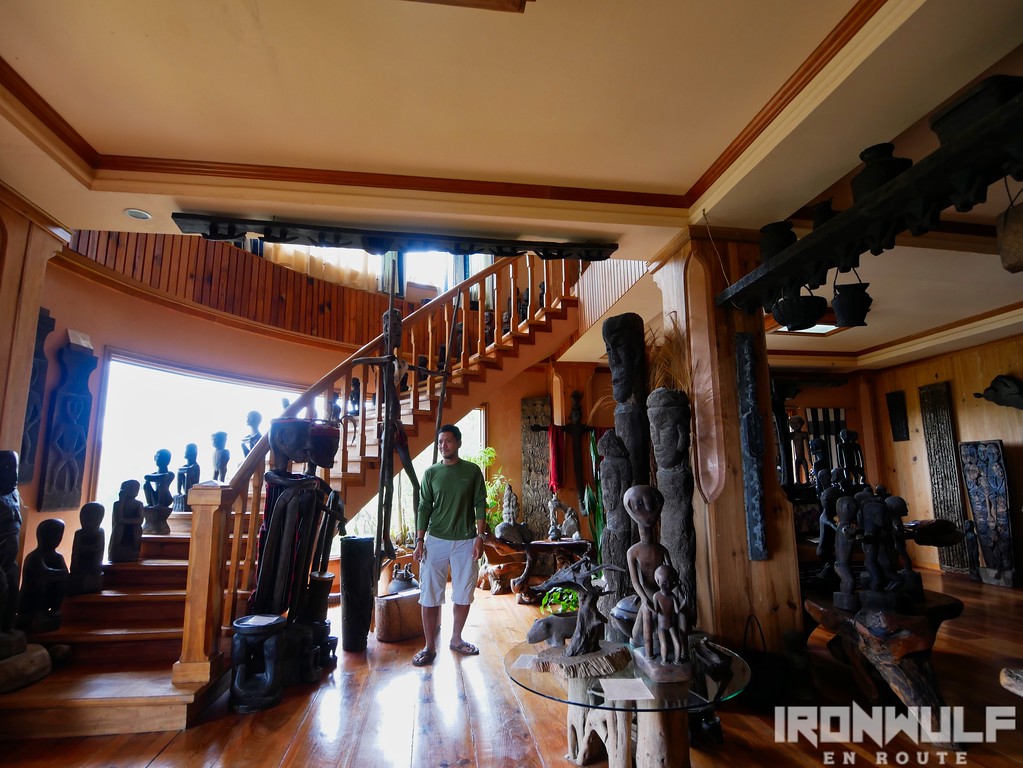“Did someone turn this wooden staff around?” I asked. There were only three of us in the museum. I can clearly remember when I first passed by this wooden staff with a carved bulul (wooden carved sculptures from Cordilleras) on top with a lock of hair that it was facing out towards the window. Going back to take a photos this time with my camera after going around, I was surprised it was looking towards the room this time. Ate Fe, our guide and care taker for the Museum of Cordillera Cultural Heritage said she did not as she was busy talking to my good friend Lagalog. I tried to move the base, it was heavy and not easy to budge. Reading the small description at the base, this wooden mahogany staff was carved by a tribal shaman in the 1970s. The bulul image inspired by the image of his wife and actual lock of hair used on the top. Gave me a little goosebumps. Was it watching over us?
Museum of Cordillera Cultural Heritage
The wooden shaman stick is just one of more than a thousand relics housed within the two-story Museum of Cordillera Cultural Heritage in Bissang, Tam-an, Banaue, Ifugao. Formerly known as the Museum of Cordillera Sculpture when it was still owned by an American octogenarian who spent a good amount of his life in Ifugao, hence his extensive collection of Cordillera relics from age-old bululs, shamanistic items, and other tools and instruments which has been an essential part of Ifugao culture.

The whole collection, museum and property was recently acquired by avid collector and traveler himself, Atty Dominador Buhain. The founder of Rex Bookstore has a similarly extensive collection of Filipino Heritage found in his The Book Museum cum Ehtnology Center in Marikina. It seems fitting to add this set of pieces to his collection.
Bululs and more
We had the whole morning to explore the Museum of Cordillera Cultural Heritage and honestly if you’re the type who is fascinated by Cordillera culture, it can be overwhelming. There is so much to see that it takes more than a second look at some of the pieces. Like the shaman staff I mentioned earlier, there’s a glass enclosed collection of other ritual pieces that seem to hold ancient energy by itself. Like the Minaho (piece 1123 and 1124), a simple looking miniature dog carving is a todak, a powerful piece that can either damn or cure a sick person when called upon by a warlock-priest.
The museum opens up to a collection of Killows (scare crows) which are often found on the rice fields to scare off birds. On display are noticeable sculpture killows from Hungduan whose balletic stance mimics a farmer shooing birds away from a field. A curious set piece of ceremonial mementos used by a Mombaki (priest) is also on the same floor. There’s a wall displaying headhunting prize sculptures among intricately carved wood panels.
A staircase adorned by a number of bululs lead visitors up to the second floor. There’s more to ogle around. Probably the oldest and most revered bulul ever found, Alawah is found here. Regarded as the King Bulul from the village of Poitan, Alawah came to be in 1902 when Banaue was raided by marauders. Banaue won as at least a number of 200 heads were lopped off. An escaping raider was shouted “Allawahon!” which means “stop” and suddenly the raider stopped on his tracks. Suddenly dead without any wounds.
There’s a lot more to see here, from the beautiful wooden jars, meticulously detailed rice harvest knives and more ritual pieces. If one ever gets tired, take a rest at one of large Hagabi benches. Maybe the one with a dog carving, quite a prevalent symbol throughout Cordillera culture as well.
Banaue is usually just a transit point for most people exploring Ifugao and the Mountain Province. But why not stay a day or two in town just to get a feel of the place. The Museum of Cordillera Cultural Heritage is an awesome introduction for those starting to explore Cordillera culture. Worthwhile for those already fascinated and wants to delve deeper into their traditions. Definitely worth spending half a day here.

Banaue Heritage Inn
The Museum of Cordillera Cultural Heritage is a rich collection of relics that is best savored slowly. Looking at each piece and unraveling their story, it would take time to process everything from one visit. Why not stay nearby?
Within the compound is Banaue Heritage Inn with several rooms to accommodate guests. It’s about 2km away from the main town. Quiet and with sweeping sunrise views of Poitan. There’s a wonderful garden to wander around. A real Ifugao house to see. For birders, there’s a trail leading up the hill for some time to commune with nature.
Essential Info
Museum of Cordillera Cultural Heritage
Bissang, Tam-An, Banaue, Ifugao
Museum Hours
9:00 am-5:00 pm
Monday-Sunday
Admission Fee
P 200.00
For inquiries, contact us:
0932.165.9176
0915.931.7460
0927.401.1484
(02) 570.4449
Facebook: /Museum-of-Cordillera-Cultural-Heritage/
For DDD Banaue Heritage Inn: /Banaue-DDD-Heritage-Inn/

Ferdz Decena is an award-winning travel photographer, writer and blogger. His works has found print in publications such as Singapore Airlines’s Silver Kris, Philippine Airlines’ Mabuhay, Cebu Pacific’s Smile and Seair InFlight. He has also lent his expertise to various organizations like the Oceana Philippines, Lopez Group Foundation, Save the Children and World Vision, contributing quality images for their marketing materials.















